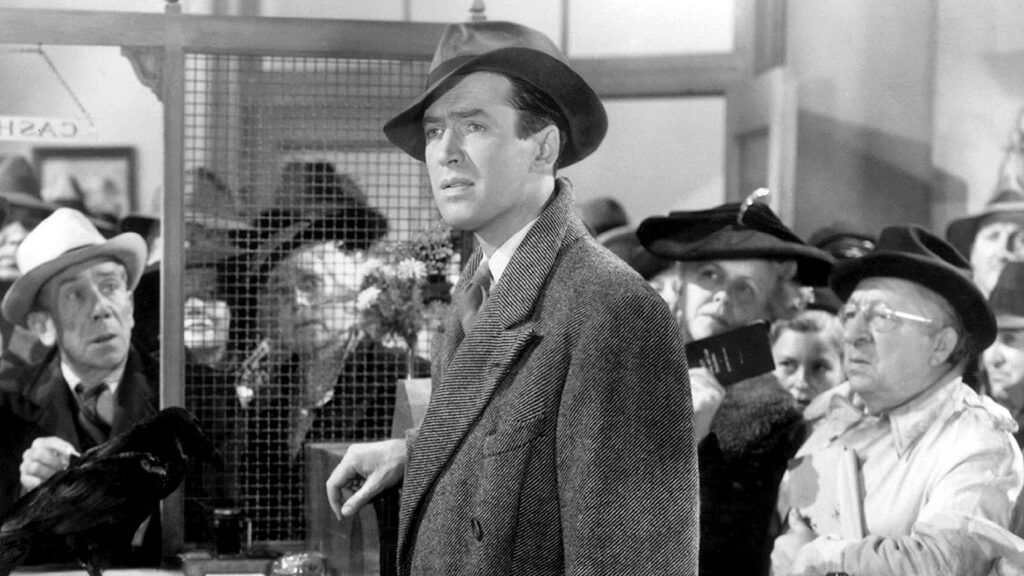A friend told me recently that seeing a movie I made more than 40 years ago is a holiday tradition in his family. That movie is It’s a Wonderful Life, and out of all the 80 films I’ve made, it’s my favorite. But it has an odd history.
When the war was over in 1945, I came back home to California from three years service in the Air Force. I had been away from the film business, my MGM contract had run out and, frankly, not knowing how to get started again, I was just a little bit scared.
Hank Fonda was in the same boat, and we sort of wandered around together, talking, flying kites and stuff. But nothing much was happening.
Read More: James Stewart on a Father’s Strength
Then one day Frank Capra phoned me. The great director had also been away in service, making the Why We Fight documentary series for the military, and he admitted to being a little frightened too. But he had a movie in mind. We met in his office to talk about it.
He said the idea came from a Christmas story written by Philip Van Doren Stern. Stern couldn’t sell the story anywhere, but he finally had 200 twenty-four-page pamphlets printed up at his own expense, and he sent them to his friends as a greeting card.
“Now, listen,” Frank began hesitantly. He seemed a little embarrassed. “The story starts in heaven, and it’s sort of the Lord telling somebody to go down to earth because there’s a fellow who’s in trouble, and this heavenly being goes to a small town, and…”
Frank swallowed and took a deep breath.
“Well, what it boils down to is, this fella who thinks he’s a failure in life jumps off a bridge. The Lord sends down an angel named Clarence, who hasn’t earned his wings yet, and Clarence jumps into the water to save the guy. But the angel can’t swim, so the guy has to save him, and then…”
Frank stopped and wiped his brow. “This doesn’t tell very well, does it?”
I jumped up. “Frank, if you want to do a picture about a guy who jumps off a bridge and an angel named Clarence who hasn’t won his wings yet coming down to save him, well, I’m your man!”
Production of It’s a Wonderful Life started April 15, 1946, and from the beginning there was a certain something special about the film. Even the set was special. Two months had been spent creating the town of Bedford Falls, New York.
For the winter scenes, the special-effects department invented a new kind of realistic snow instead of using the tried and true cornstarch.
As one of the longest American movie sets ever made until then, Bedford Falls had 75 stores and buildings on four acres with a three-block main street lined with 20 full-grown oak trees.
As I walked down that shady street the morning we started work, it reminded me of my hometown, Indiana, Pennsylvania. I almost expected to hear the bells of the Presbyterian church, where Mother played the organ and Dad sang in the choir.
I chuckled, remembering how the fire siren would go off, and Dad, a volunteer fireman, would slip out of the choir loft. If it was a false alarm, Dad would sneak back and sort of give a nod to everyone to assure them that none of their houses were in danger.
I remembered how, after I got started in pictures, Dad, who’d come to California for a visit, asked, “Where do you go to church around here?”
“Well,” I stammered, “I haven’t been going—there’s none around here.”
Dad disappeared and came back with four men. “You must not have looked very hard, Jim,” he said, “because there’s a Presbyterian church just three blocks from here, and these are the elders. They’re building a new building now, and I told them you were a movie star and you would help them.”
And so Brentwood Presbyterian was the first church I belonged to out here.
Read More: James Stewart’s Inspired Performance
Later, that church was the one in which Gloria and I were married. A few years after that it was the same church I’d slip into during the day when Gloria was near death after our twin girls were born. Then after we moved, we attended Beverly Hills Presbyterian, a church we could walk to.
It wasn’t the elaborate movie set, however, that made It’s a Wonderful Life so different; it was the story. The character I played was George Bailey, an ordinary fella who thinks he’s never accomplished anything in life.
His dreams of becoming a famous architect, of living adventurously, have not been fulfilled. Instead he feels trapped in a humdrum job in a small town. And when faced with a crisis in which he feels he has failed everyone, he breaks under the strain and flees to the bridge.
That’s when his guardian angel, Clarence, comes down on Christmas Eve to show him what his community would be like without him. The angel takes him back through his life to show how our ordinary everyday efforts are really big achievements.
Clarence reveals how George Bailey’s loyalty to his job at the building-and-loan office has saved families and homes, how his little kindnesses have changed the lives of others and how the ripples of his love will spread through the world, helping make it a better place.
Good as the script was, there was still something else about the movie that made it different. It’s hard to explain. I, for one, had things happen to me during the filming that never happened in any other picture I’ve made.
In one scene, for example, George Bailey is faced with unjust criminal charges and, not knowing where to turn, ends up in a little roadside restaurant. He is unaware that most of the people in town are arduously praying for him.
In this scene, at the lowest point in George Bailey’s life, Frank Capra was shooting a long shot of me slumped in despair.
In agony I raise my eyes and, following the script, plead, “God… God…dear Father in heaven, I’m not a praying man, but if you’re up there and you can hear me, show me the way. I’m at the end of my rope. Show me the way, God…”
As I said those words, I felt the loneliness, the hopelessness of people who had nowhere to turn, and my eyes filled with tears. I broke down sobbing. This was not planned at all, but the power of that prayer, the realization that our Father in heaven is there to help the hopeless, had reduced me to tears.
Frank, who loved spontaneity in his films, was ecstatic. He wanted a close-up of me saying that prayer, but was sensitive enough to know that my breaking down was real and that repeating it in another take was unlikely. But Frank got his close-up.
The following week he worked long hours in the film laboratory, repeatedly enlarging the frames so that eventually it would appear as a close-up on the screen. I believe nothing like this had ever been done before. It involved thousands of enlargements with extra time and money. But he felt it was worth it.
There was a growing excitement among all of us as we strove day and night through the early summer of 1946. We threw everything we had into our work.
Finally, after three months, shooting some 68 miles of 35-millimeter film, we completed the filming and had a big wrap-up party. It was an outdoor picnic with three-legged races and burlap-bag sprints, just like the picnics back home.
Frank talked enthusiastically about the picture. He felt that the film and actors would be up for Academy Awards. Both of us wanted it to win, not only because we believed in its message, but also for the reassurance we needed in this time of starting over.
But life doesn’t always work out the way we want it to.
The movie came out in December 1946, and from the beginning we could tell it was not going to be the success we’d hoped for. The critics had mixed reactions. Some liked it; others felt it was “too sentimental…a figment of simple Pollyanna platitudes.”
As more reviews came out, our hopes sank lower and lower. During February 1947, eight other current films, including Sinbad the Sailor and Betty Grable’s The Shocking Miss Pilgrim, outranked it in box-office income.
The postwar public seemed to prefer lighthearted fare. At the end of 1947, It’s a Wonderful Life ranked twenty-seventh in earnings that season. And although it earned several Oscar nominations, despite our high hopes, it won nothing. “Best picture for 1946” went to The Best Years of Our Lives.
By the end of 1947 the film was quietly put on the shelf.
But a curious thing happened. The movie refused to stay on the shelf. Those who loved it loved it a lot, and they told others. They wouldn’t let it die any more than the angel Clarence would let George Bailey die. When it began to be shown on TV, a whole new audience fell in love with it.
Today, after some 40 years, I’ve heard the film called “an American cultural phenomenon.” Well, maybe so, but it seems to me there is nothing phenomenal about the movie itself.
It’s simply about an ordinary man who discovers that living each ordinary day honorably, with faith in God and a selfless concern for others, can make for a truly wonderful life.
For more inspiring stories, subscribe to Guideposts magazine.





